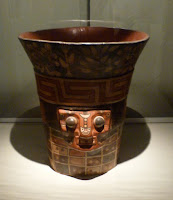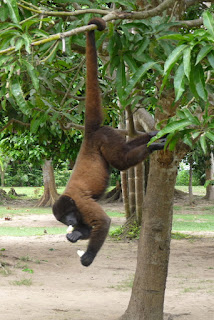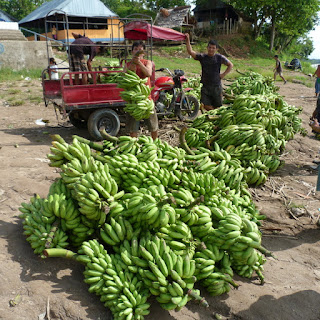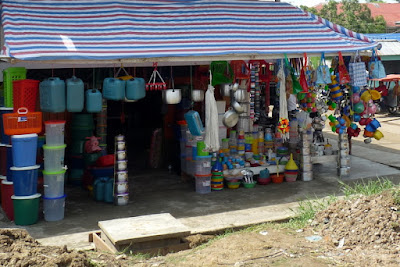 Nearly two-thirds of Peru is Amazon rainforest, containing some of the richest biodiversity on the planet. Here live some 400 species of mammals (including the rare pink dolphin), 2000 species of fish (more than the Atlantic Ocean), 300 reptiles (including the anaconda - the world’s largest non-poisonous snake), 4000 birds (including 120 different species of hummingbirds), and more than 50,000 species of plants (including these water hyacinths).
Nearly two-thirds of Peru is Amazon rainforest, containing some of the richest biodiversity on the planet. Here live some 400 species of mammals (including the rare pink dolphin), 2000 species of fish (more than the Atlantic Ocean), 300 reptiles (including the anaconda - the world’s largest non-poisonous snake), 4000 birds (including 120 different species of hummingbirds), and more than 50,000 species of plants (including these water hyacinths).
Covering over 2.5 million square miles, the Amazon basin represents over 50% of all remaining rainforest on the plant. It is a vast, largely impenetrable area, with the small human population in all of Peru. We flew into Iquitos, which has a population of 400,000 – it is the world's largest city that cannot be reached by road, only by water or air. The city is in the heart of the jungle, 2300 miles from the Atlantic Ocean. Here we boarded our river taxi for the transfer to our lodge.
*************
The Ceiba Tops Lodge was our home on the banks of the Amazon – about 25 miles downriver from Iquitos – the most luxurious (i.e., air-conditioned rooms) of several lodges run by the Explorama group. It was a LONG climb from the floating dock to the top of the bank. The steps were marked to show the high water levels for the past seven years - if we'd been smart, we'd have come in May 1999 when the water was a lot closer to the lodge. From here we explored the myths, mysteries and magic of the world’s most exotic jungle – and gratefully slipped back into our cool rooms at night. For the record, it was hot and humid here – temperatures near 100 degrees – we should have lost weight with all the sweating we did!


The lodge is named for an immense Ceiba tree on the property. Ceiba trees can grow up to 200 feet in height and live for hundreds of years. Its base is thick and spreads out in buttress roots. Its trunk is straight, with few branches except at the top, where it spreads into a huge canopy. The Ceiba tree figures in the mythologies of pre-Columbian cultures in Latin America, where the world tree is depicted as a Ceiba trunk connecting the planes of the underworld, the terrestrial realm and the skies. It’s impressive, no doubt about that.
We didn't have to go far to see wildlife. There was plenty around the lodge. Without a doubt, the cutest critter on the property was an orphaned young tapir. Tapirs are large browsing mammals, similar in shape to a pig, with a short prehensile snout. This little one came visiting nearly every morning.


A pair of scarlet macaws came around every morning and sat outside the dining hall - hoping for a handout. We didn't see any of these beauties in the wild, so it was a treat to have them say hello as we went for breakfast.
Our room was some distance from the dining hall, facing the jungle. It was pretty quiet back there, and we could do some wildlife viewing right in our doorway. We saw a red brocket deer, some saddle-back tamarins, and a beautiful blue morpho butterfly.
 The red brocket deer is fairly common in the forests of South America. Fawns, such as this one, have white spots. S/he was only about two feet tall.
The red brocket deer is fairly common in the forests of South America. Fawns, such as this one, have white spots. S/he was only about two feet tall.
 Saddle-back tamarins live in the trees around the lodge - we heard them often and saw them occasionally. They grow up to 12 inches long, not including the tail which adds on another 17 inches, and weigh up to 2 pounds. They have white cheeks and beautiful black and mahoghany coloring.,
Saddle-back tamarins live in the trees around the lodge - we heard them often and saw them occasionally. They grow up to 12 inches long, not including the tail which adds on another 17 inches, and weigh up to 2 pounds. They have white cheeks and beautiful black and mahoghany coloring.,
 The Blue Morpho butterfly is an irridescent, metallic blue flash of color - they are forest dwellers (we saw several in the jungle), but they occasionally venture out into the sunshine to warm themselves. This one was big - nearly 6 inches across.
The Blue Morpho butterfly is an irridescent, metallic blue flash of color - they are forest dwellers (we saw several in the jungle), but they occasionally venture out into the sunshine to warm themselves. This one was big - nearly 6 inches across.
Birds were abundant everywhere. We saw plenty of birds around the lodge, but we really saw loads of them on an early morning boat ride: yellow-headed caracara, russet-backed weaver, smooth-billed ani, tropical kingbird, shiny cowbird, oriole blackbird, canary-wing parakeet, chestnut-bellied seedeater, social flycatcher, great kiskadee, silver beak tanager, striated heron, roadside hawk, black vulture, white-eyed parakeet, ringed kingfisher, greater tern, crimson-headed woodpecker, gray soltater, yellow-headed vulture, red-breasted blackbird (an Alaska migrant), yellow-hooded blackbird, gray-winged trumpeter, and large bill tern. Pictured here are the oriole blackbird and the red-breasted blackbird.


One evening we ventured out into the jungle to see what we could find in the dark. Left to our own devices, we probably wouldn't have seen a thing, but our guide was determined to find a tarantula. He spotted a red-bottom tarantula, about 6 inches across. Along the way we saw a no-tail scorpion, a leaf-mimicking toad, and assorted other frogs, toads and insects.
We had most of our meals at the lodge, though we sometimes stopped for breakfast or lunch at one of the other lodges owned by the same company. The food wasn’t memorable, but each evening we were treated to some kind of entertainment. Most nights it was a band made of up various staff members (different group each time), and one night we had a dance exhibition by students at a school a few miles down the river.


**********************************************************
The map below shows the location of the Ceiba Tops Lodge relative to the area we explored during our days in the rainforest – a long stretch of the Amazon and a big loop of the tributary Napo River.

************************************************************
The Fundo Animal Sanctuary is located on an island near the Ceiba Tops Lodge. It is a rescue center that provides a home to numerous species of monkeys, as well as snakes, turtles, birds, and other mammals - all were orphaned or injured and brought here for rehabilitation. It is a family-run operation whose staff and volunteers take care of the animals and work toward reforestation of medicinal plants, timber and fruit trees that provide food for them.
Here are some of the animals we met on the island:
Wooly monkeys live throughout South America. They eat fruit, leaves, seeds and flowers. They are considered highly endangered due to human hunting for food and for the illegal pet trade.
The white-throated toucan is large, loud, and brightly colored. They eat mostly fruit and live throughout the Amazon.
 Anacondas are large, non-venomous snakes found in tropical South America. They kill their prey by crushing. This young yellow-belly anaconda is only about 8 feet long; at maturity, it may reach 30-33 feet in length.
Anacondas are large, non-venomous snakes found in tropical South America. They kill their prey by crushing. This young yellow-belly anaconda is only about 8 feet long; at maturity, it may reach 30-33 feet in length.
The yellow-bellied spider monkey is highly endangered species, mostly due to deforestation of its habitat. Their name (spider) comes from their disproportionately long limbs and tail.
Squirrel monkeys live in the canopy layer of tropical forests in Central and South America. Because of their black-and-white face, they are sometimes called 'death's head monkey.'
Three-toed sloths are tree-living mammals found in Central and South America. They come to ground only to defecate - they cannot walk on all four limbs, but use their front arms and claws to drag themselves across the rainforest floor. Famously slow-moving, the sloth travels at top speeds of 0.15 mph.
 The red-tailed boa constrictor is a fairly large snake, growing up to 12-13 feet in length. They are said to make good pets, but this one seemed distinctly unfriendly.
The red-tailed boa constrictor is a fairly large snake, growing up to 12-13 feet in length. They are said to make good pets, but this one seemed distinctly unfriendly.
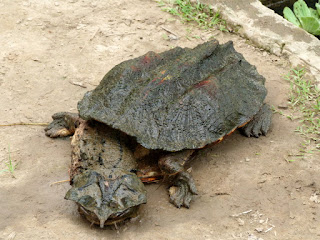 The mata mata turtle is a freshwater turtle found in the Amazon - it can reach up to 18 inches across, weighing as much as 35 pounds. It is well-camouflaged in backwater streams - its shell looks like bark and its head resembles fallen leaves.
The mata mata turtle is a freshwater turtle found in the Amazon - it can reach up to 18 inches across, weighing as much as 35 pounds. It is well-camouflaged in backwater streams - its shell looks like bark and its head resembles fallen leaves.
 The blue and yellow macaw is a spectacular resident of the tropics - with a very strong beak for crushing nuts.
The blue and yellow macaw is a spectacular resident of the tropics - with a very strong beak for crushing nuts.
 Capuchin monkeys were named for their resemblance to the Capuchin Friars, who wear brown robes with large hoods covering their heads. They live in trees and spend most of their days searching for food.
Capuchin monkeys were named for their resemblance to the Capuchin Friars, who wear brown robes with large hoods covering their heads. They live in trees and spend most of their days searching for food.
************************************************************
There are about 20 species of piranha in the Amazon River, and most are said to be quite harmless, even docile. The ones with the nasty reputation for aggressive behavior are the red-bellied piranha, which will eat just about anything - other fish, sick and weakened animals, even parts of people. Piranhas are famous for their razor-sharp teeth; native people catch the piranha and use their teeth to make tools and weapons.
To get a first-hand look at these vicious little predators, we headed out in a small boat on a piranha fishing expedition. Armed with fishing poles and chunks of raw beef, we mostly fed the piranhas – they are devilish hard to catch.
 Fortunately, there were a few experts on board and we brought home enough fish for supper that night – lots of bones, but oh so delicious.
Fortunately, there were a few experts on board and we brought home enough fish for supper that night – lots of bones, but oh so delicious.
 The family fishing near us was having a lot more luck with their traditional methods - they had big catch with many different types of fish, but they didn't invite us home for dinner...
The family fishing near us was having a lot more luck with their traditional methods - they had big catch with many different types of fish, but they didn't invite us home for dinner...
***********************************************************
The Yanamono Medical Clinic was founded in 1990 by Dr. Linnea Smith, who spent a week’s vacation on the banks of the Amazon and fell in love with the rainforest. In June 1990, she took a three-month leave of absence from her practice and returned to Peru armed with stethoscope, a bottle of pre-natal vitamins, and a few doses of antibiotics. At that time, the closest available medical care was fifty miles away and reachable only by the slow-moving "river taxi” or by dugout canoe.
Smith set up shop in a thatched-roof room offered to her by the Explorama Lodge and, by the light of a kerosene lantern, began providing primary care to the local people. Not only was there no nursing help, ambulance service, pharmacy, or basic equipment such as an X-ray machine, there wasn't even electricity or running water. Dr. Smith began travelling back and forth between her home in Wisconsin and the Amazon - returning to the jungle to provide medical care to a growing number of patients, almost all of them poor and acutely ill.
During one of her trips home, she captured the attention of a local architect who organized a project to build a clinic for her on the banks of the river. The new clinic features solar panels to provide a limited amount of electricity and to power a water pump. It also has rainwater-collecting tanks, a waiting room, office space, a pharmacy, two exam rooms, a room for patients to stay overnight, a small lab, a dental room, and living quarters for the staff who board there.

The clinic now treats over 3000 patients per year, and most of them arrive on foot or by dugout canoe. Services include family planning; prenatal care and birthing; trauma care; dental care; treatment of snakebite, cholera, parasites, malaria, and other infectious diseases. Dr. Smith is also training local people to become more involved in Yanamono. By handing over some of her responsibilities to others, she has been able to scale back her own involvement in the clinic. After living full-time in the jungle for a decade, Smith now divides her time between Peru and the U.S., spending half the year in each country.
Our travel company’s philanthropic arm, the Grand Circle Foundation, provides grants to support a well child clinic, which offers a physical exam, worm medicine, dental fluoride treatment, a toothbrush, and vitamins to the children. Roughly one-quarter of Peruvian infants do not survive to adulthood, and, hopefully these simple measures provide an edge for the children in this area.
**********************************************************
Near Yanamono, we stopped to visit our guide’s uncle, who just happens to operate a rum distillery and village bar. Uncle Cesar uses lots of sugarcane to make four different types of rum - all of which we had to taste. First was pure rum (aka firewater), then a blend of rum and molasses, next a blend of rum, ginger and honey, and finally a concoction known as "siete raicis" or "seven roots." This last one goes down way too easy - it's known locally as Jungle Viagra.

Near the rum factory, we had a good look at some water buffalo. Water buffalo were introduced into the Amazon River basin in 1895; they are now used extensively for meat and dairy production.
***********
The Amazon Conservatory of Tropical Studies is a rainforest research station and the home of the longest rainforest canopy walk in the world. Wooden steps provide access from the forest floor to a multilevel system of aerial pathways and platforms that are suspended by ropes and cables. It’s like walking a series of suspended bridges – the width of a board and swinging in the breeze.
We ascended the walkway to a height of more than ten stories and eventually reached the top of the seemingly endless canopy. Some of the trees we pass can hold up to two thousand epiphytic plants in their branches and harbor an estimated twenty million insect species. Looking down on tree-tops can be a little disconcerting - such looks different from up here.
 The canopy walk was built without driving nails into any of the trees – it is an engineering marvel, to be sure. Amazingly enough, it was designed and built by our guide’s father, a native Indian who worked for many years as the Explorama Lodge’s master carpenter.
The canopy walk was built without driving nails into any of the trees – it is an engineering marvel, to be sure. Amazingly enough, it was designed and built by our guide’s father, a native Indian who worked for many years as the Explorama Lodge’s master carpenter.
**************************************************************
Walking to and from the canopy walkway (about an hour each way), we saw lots of plants and wildlife. Suffice it to say that the trees were tall, the vines were dense - and there was too much information too fast to remember. At least a few animals got captured by the camera:
This brown monitor lizard kept an eye on us as we tramped through his backyard. These carnivorous reptiles can grow up to several feet in length.
 The Peru poison frog is hard to spot because it is so well-camouflaged for life on the jungle floor. Its toxicity helps it avoid predators, but it's endangered due to logging and loss of habitat.
The Peru poison frog is hard to spot because it is so well-camouflaged for life on the jungle floor. Its toxicity helps it avoid predators, but it's endangered due to logging and loss of habitat.
 A family of black-mantled tamarins danced around the trees overhead. The adults are only about 10 inches tall, with tails about 12 inches in length.
A family of black-mantled tamarins danced around the trees overhead. The adults are only about 10 inches tall, with tails about 12 inches in length.
The pygmy marmoset is a dwarf monkey native to the rainforest canopy. It is the smallest monkey in the world - only 5-6 inches tall.
 This mealy parrot lived near the Napo Lodge (at the foot of the canopy walk). He pretty much drowned out all conversation until the staff relented and gave her something to eat.
This mealy parrot lived near the Napo Lodge (at the foot of the canopy walk). He pretty much drowned out all conversation until the staff relented and gave her something to eat.
 Another noisy resident was the beautiful blue and yellow macaw. He spent most of his time hiding in the thatched roof, but his curiosity got the best of him ...
Another noisy resident was the beautiful blue and yellow macaw. He spent most of his time hiding in the thatched roof, but his curiosity got the best of him ...
Perhaps the most curious bird of the day was this Grey-winged Trumpeter. He wandered around near the canopy walk and then followed us when we went to visit the shaman. He stayed for the entire session - wandering around the circle getting his head scratched.
The white-tailed trogon was the most exciting bird sighting from the canopy walkway - he actually sat still for a few minutes. Other spottings (no pictures) included a long-bill wood clipper and a slate-headed flycatcher.
*************************************************************
Not far from the canopy walk is a small community of Yagua Indians, the tribe considered most characteristic of the region. It was the Yaguas who gave the Amazon its name. When the Spaniards first came to the Amazon, they saw the Yaguas with their long hair and grass skirts and thought they were women. Subsequently, the Spanish named the Amazon River after the Greek myth of the Amazon women warriors.
The "grass skirts" that are typical Yagua attire are actually made from the fiber of the aguaje palm. Sometimes, a red dye is used to color the fibers and to paint the skin. The Yagua still rely on the rain forest for much of their clothing, but many of the women make their skirts out of cloth that they purchase.
We were invited in the community house for an exhibition (with group participation, of course) of traditional dances – accompanied by the music of native instruments. We heard about the Yagua’s own traditional alcoholic beverage called masato, which is made by chewing and fermenting the root of the yucca plant. Masato is consumed by the Yaguas in large amounts during festivals – thankfully, we just attended an exhibition – no tasting required.
 Yaguas are famous for their use of blowguns, a highly effective hunting tool still commonly used. Shotguns may be a more efficient means of hunting, but blowguns are still used for economic reasons - shotgun cartridges are just too expensive. Curare-tipped darts are used with the blowgun. Curare is a fast-acting poison that does not directly kill its victim. It causes paralysis; death is caused by suffocation when the victim's lungs are paralyzed. The ancient knowledge of making the curare mixture has been passed down for generations by Yagua shamans.
Yaguas are famous for their use of blowguns, a highly effective hunting tool still commonly used. Shotguns may be a more efficient means of hunting, but blowguns are still used for economic reasons - shotgun cartridges are just too expensive. Curare-tipped darts are used with the blowgun. Curare is a fast-acting poison that does not directly kill its victim. It causes paralysis; death is caused by suffocation when the victim's lungs are paralyzed. The ancient knowledge of making the curare mixture has been passed down for generations by Yagua shamans.
**********************************************************
Break time ....
**********************************************************
The ReNuPeRu Ethnobotanical Garden is a teaching garden tended by a local shaman and his apprentices. It contains over 250 species of local rainforest plants used in modern medicine as well as native plant remedies which science may use in the future.
 We had an interesting visit with Don Guillermo, the shaman, or curandero, who showed us many examples of traditional medicinal plants. He made us believe that the rainforest is a veritable pharmacy - he had plants for treating arthritis, asthma, diabetes, cancer, snake bites, high cholesterol, parasites, insomnia, colds and coughs, toothache, assorted aches and pains - even something for weight loss. We came home with some cat's claw salve that will cure almost anything and a magic potion for itchy mosquito bites.
We had an interesting visit with Don Guillermo, the shaman, or curandero, who showed us many examples of traditional medicinal plants. He made us believe that the rainforest is a veritable pharmacy - he had plants for treating arthritis, asthma, diabetes, cancer, snake bites, high cholesterol, parasites, insomnia, colds and coughs, toothache, assorted aches and pains - even something for weight loss. We came home with some cat's claw salve that will cure almost anything and a magic potion for itchy mosquito bites.
********************************************************
Not far from the Ceiba Tops Lodge is the town of Indiana, established by Canadian missionaries in the 1960’s. For this area, it is considered a model town – it has wide roads, several schools, even a small hospital. We took a very round-about route to visit Indiana.
First, we travelled by small boat to the village of Mazan – in the opposite direction of Indiana. Mazan sits on the narrow neck of a huge loop in the Napo, with its 2-mile, 2-lane concrete road saving about 75 miles of boating.
Mazan was a lively scene, with boats crowding in from two sides – the Amazon on one end and the Napo River on the other. On the Amazon side of town, where we landed, the banana business was brisk.
 Besides bananas, folks were loading other goods, produce and livestock to carry to larger markets upstream. River taxis were also in and out - crowded, but less work than paddling a dugout canoe.
Besides bananas, folks were loading other goods, produce and livestock to carry to larger markets upstream. River taxis were also in and out - crowded, but less work than paddling a dugout canoe.
Our guide had arranged for a small army of 'motocars' to meet us. These charming little vehicles are modified motorcycles imported from China - we travelled by twos, but the locals pile in all sorts of things. We headed inland to see the town.
Mazan has a few concrete buildings, but the majority of the houses, shops and restaurants were wooden. They are generally on stilts to cope with flooding and full of breeze gaps to reduce dampness. Some are pretty, but most look either unfinished or tumbledown.
On the Napo River side of town, there were lots more long skinny boats known as ‘piqui-piqui.’ Folks were arriving here from deep in the rainforest - to join the fun at the Mazan market.
We took a walk through the market - it was lively and coloful - and there were lots of fruits, vegetables and meats that we didn't recognize, but that didn't stop us from looking - and even tasting some strange things that our guide deemed safe for gringoes.


The locals seemed a bit surprised to see us in their small town, but they smiled and made us feel welcome. Throughout the trip, people along the river were most welcoming as they went about their daily lives - catching fish from the river, farming along the banks, swimming and washing clothes along the shore. Here are some of the folks we met in Mazan.


We spent a fair amount of time in boats just to get from one place to another. This mode of travel allowed us to catch some interesting glimpses of boats and buildings along the river.
Buildings are pretty basic – mostly thatched-roof huts, though some folks can afford cinder blocks and tin roofs.
There are boats of every size and shape.








